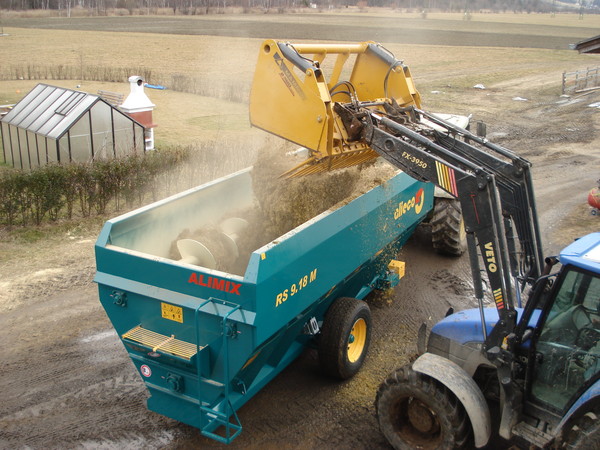
Unifeed, mechanical system to ensure valance feed
Total Mixed Ration feed wagons are now the norm in most animal husbandry units and have seen continual technical evolution designed to improve productivity, but also the welfare of the animals
In Italy, it’s called ‘unifeed’, or ‘one-plate’ feeding; in a more international and technical style, Total Meal Ration, or TMR: but wherever you farm, one result has been a fundamental change in how animals are raised and the techniques of meat and milk production.
A history of how the diet of farmyard animals has been manipulated to improve productivity would probably have to stretch back centuries, perhaps millennia, but the most recent developments have been sparked in part by the observation that, like human dieters, animals too tend to cherry-pick their food for the best bits.
This is why a key idea in modern feed techniques is thorough mixing. The forage, grains, protein supplements, minerals and vitamins have to be mixed so well that a cow or other animal has very little chance of picking out what looks tasty. They have to eat the whole lot.
Of course, animal dieticians decide what the best rations are for each phase of an animal’s lactation or growth cycle, supplying a high concentration of energy and exploiting interactions between the foodstuffs to keep acidity low and maintain proper digestion.
But it is the machinery used to mix the food that ensures that the animals in fact eat and swallow what they are given. The basic tool is the mixer wagon, which can usually chop as well as mix. The wagons can be self-propelled or towed and will have one or more spiral augurs arranged according to a range of configurations.
The most visible component is the mixing hopper, made of metal sheeting, in some cases stainless steel or hardox for reduced wear. This is where the augurs churn and mix the feed as they move it towards the delivery point. The augurs were initially mounted horizontally, but vertical configurations of conical augurs have progressively taken over the field because they make better use of gravity to improve mixing.
In both cases, the augur may be fitted with almost always retractable blades to chop up long stemmed forage. If the blades are allowed to chop too long, the ration may be chopped too small, which the animals, especially ruminants, will find more difficult to digest.
Self-propelled feed wagons in particular are also fitted with the machinery needed to remove feed from silos, usually on a telescopic arm, which is inserted into the silo where a cutting head gouges out and chops the stored feed, loading it onto a conveyor system into the hopper. For towed wagons, a separate machine usually does this job.
The hopper rests on load cells to measure the amount of the various foodstuffs added. The load readings appear on a display in the cab where the operator can ensure he loads the right proportions of the various ingredients on the pre-set recipe he is given for each job.
The hopper has hydraulically operated doors and a conveyor belt to deliver the feed mix to the mangers. In many cases, the belt can swing out for better access to the file of mangers in larger barns. Then, feeding time begins, with no concessions for cherry-picking cows.
Calf-Small
The self-propelled MiniMixer feed wagon, made by Storti from near Verona and winner of a special mention award at the EIMA 2012 industrial fair, was designed for feeding white-meat veal calves, which under EU regulations, must now be raised in groups rather than held within often cruelly restrictive individual cages. The wagon has a smaller than usual horizontal augur capable of handling 0.75 m2 of feed. The multi-flow augur uses counter-rotating spirals to shift the feed from the hopper’s external walls to the centre. Two more external augurs of the same design improve mixing. The hopper, augurs and all other parts in contact with the feed are made of stainless steel to avoid iron contamination of the mix.
The painted steel frame is fitted with four stainless steel load cells on which the hopper rests so the operator can check how much of each ingredient is added. The power comes from an 800 W electric motor with reverse, a two-wheel drive differential gear and negative brakes. The two steering wheels are mounted on pivots. A handle holds the controls, for forward and backward movement, cab door opening and closing, emergency switch, and ignition key.
The augur’s power comes from a 1.5 W electric reducer and a dedicated reverse; torque and speed can be modulated. Rapid unloading is enabled by a 250 by 260 mm door on each side, which helps avoid difficult U-turns to deliver to both sides of a manger aisle. The power comes from a battery pack under the hopper – in the standard version, with four 6 V units at 200 Ah each. The number of batteries can be doubled on request, to increase range.
Kitchen Robots in the Barn
AFS, or an Automatic Feeding System is the farmer’s equivalent o a kitchen robot, designed to ensure correct rations for each animal in a herd. The full system consists of a stockpile of foodstuffs in a storage area, the mixer and lastly distribution, but if the purse strings are tight, only one or two of the three sectors can be given automatic handling.
AFS in fact requires heavy investments and may require the feeding barn, or even the configuration of the farm buildings as a whole to be altered. The best time to move to AFS may be when a new barn is being planned. In either case, a specific area is set aside for the ‘pantry’, where the raw materials are stored, on separate loading platforms for each ingredient, or at least in clearly separated areas. The mixer may be fixed and installed near the ingredients store. A mobile device, perhaps buckets on overhead rails, is then used for distribution.
One advantage of this configuration is that while distribution is taking place the mixer can prepare another ration, which is helpful if the barn is very large. In other cases, there may be no room for rails or technical reasons for not modifying the buildings in which case the distribution wagon can also do the mixing following certain pre-set routes, a stop device being available for emergencies.
A key requirement for a successful AFS is that the feed ingredients should always be available for mixing. This depends on available space and the feed’s components. For example, concentrated feeds can be stockpiled in silos in large quantities, whereas siloed forage should not be allowed to accumulate too much to avoid the risk of fermentation. As a general rule, 2-3 days of back-up stock is thought to be enough.
When AFS is coupled with the use of milking robots, the number of feed distributions each day is increased to stimulate the animals to move more and maintain optimal digestive conditions, especially as regards acidity. Some distribution systems also check whether all the feed distributed previously has been consumed; if not, none is added. In another plus, if AFS replaces a traditional towed mixer wagon, one tractor less is needed to work the equipment.








